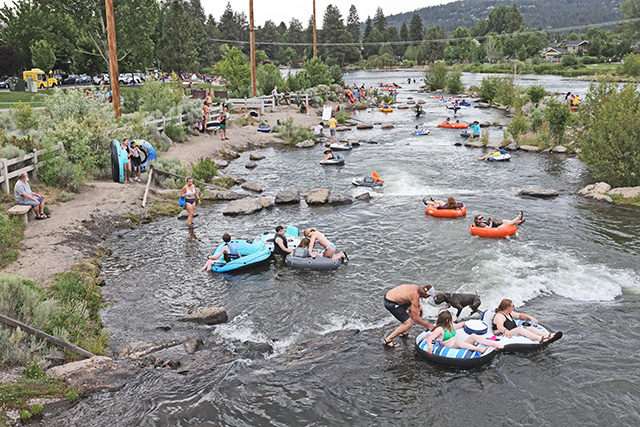Bend entrepreneur’s handmade fly rods are unique to each customer
Published 5:45 am Monday, April 29, 2024

- Custom fishing rod builder Bill Amerongen works on a custom steelhead fishing rod he’s building for a client, in his home workshop in Bend Monday afternoon.
Bill Amerongen doesn’t have to fish for compliments.
The praise just comes to him from the repeat customers who like the quality of workmanship on his handmade fishing rods and handles. By wrapping each rod in bright colored thread, he creates intricate, geometric designs that are as eye-catching as they are unique.
He’s found success without a large production or sales staff at Highliner Custom Rods. A website has been enough to attract new business.
“The main thing that drove this was that I was a fisherman,” said Amerongen, a 67-year-old Bend resident. “People come to me because they want something special and one of a kind.”
Amerongen is one of those entrepreneurs who has turned a hobby into a business. During the past 25 years or so he’s churned out several thousand custom designed fishing rods for customers around the globe. The rods sell for anywhere for a $1,000 to $3,000, Amerongen said.
They’re totally worth it, said Greg Sherman, a Seattle resident who has purchased two rods.
“I love my rod,” Sherman said. “One of the things I noticed the most is how I can feel the fish bite better. I buy things to use. It’s an heirloom and I’ll pass it down to my son. Bill (Amerongen) is crating usable art. It’s not anything you’d ever see in a fly shop.”
Grip, rod type and design colors customized
The rods start out as blanks for all kinds of fishing: Fly and spey, salmon and steelhead, saltwater and travel rods. Amerongen then fashions the rods with tightly wrapped threads in vivid, geometric designs or uses cork sized to the right grip tailored to individual clients.
Not only are the grips customized, but so are the guides that hold the fishing line on the rod, Amerongen said.
Making eye-catching and unique designs is one thing, but making the rods perform better is quite another, Amerongen said. Through trial and error Amerongen found that the spacing of the line guides affects performance, and the ability to catch more fish.
He’ll often have the customer choose a rod blank, choose a color, rod design and other components. The process takes place either in person or via email, with samples being sent back and forth as Amerongen customizes each component to the customer’s specifications, he said.
The rod grips are not standardized and are made from cork sourced in Portugal, or of carbon fiber built from scratch, he said. Everything from the diameter to weight is customized.
“People come to me because they want something special and one of a kind,” Amerongen said. “Customers find me by word of mouth or from my website.”
Sherman said when he ordered his first rod as a gift for a boss, Amerongen interviewed him and kicked around ideas.
“We became friends through the process,” Sherman said. “It was a very cool experience. He sent us samples of the threads he used to match our company logo. It was a piece of art.”
‘My style of work is rare’
Amerongen’s hobby-turned-businesses started when he was in a sporting good store years ago and realized how boring all the fishing rods looked. The standardization led him to his vision of a rod that was personalized.
At first it was very labor intensive and the early ones were not very good, he said. But then he met a fishing rod craftsman in southern Oregon who taught him the art of threading on a fishing rod.
“My style of work is rare,” Amerongen said. “In this day and age, we live in a world where can learn to do anything.”
It usually takes Amerongen 60 to 80 hours of labor to customize a fishing rod.
“It’s a passion,” he said. “You don’t get wealthy making these high-end fishing rods because they’re so labor intensive.”
Typically at a sporting good store, a top tier rod will cost about $1,500, said Laith Petersen, manager of the Confluence Fly Shop at the Old Mill District in Bend.
“Some customers like customized rods, especially those who have disposable income where you can think about these things,” Petersen said.
Advice on turning side hustles to careers
Entrepreneurs often start their business ventures off as side hustles, said Todd Laurence, Oregon State University-Cascades adjunct instructor and executive director of SnoPlanks Academy. They can start small and stay small, or they can grow and scale, adding more employees, Laurence said.
“When a business demonstrates strong product-market fit, by acquiring customers with increasing ease, the entrepreneur often faces a tough decision whether or not to convert their side hustle to their main source of income or go all in on the growing business,” Laurence said. “This is a hallmark of a successful entrepreneurial venture, but it is not a requirement.”
Finding a niche and turning a profit is a sign of success for any entrepreneur, said Laurence, who said these views are not what is typically found in a textbook.
Even though more than a thousand Highliner rods have been sold, Amerongen has yet to see one of his rods in use in the wild.
He hopes to one day.
“It would be cool to see, though,” Amerongen said. “It’s a neat thing when people text photos of their trip they went on using the rod I built. It’s kind of a funny feeling when I drop off a finished rod at FedEx. It’s like I’m sending one of my babies off for an amazing adventure.”







